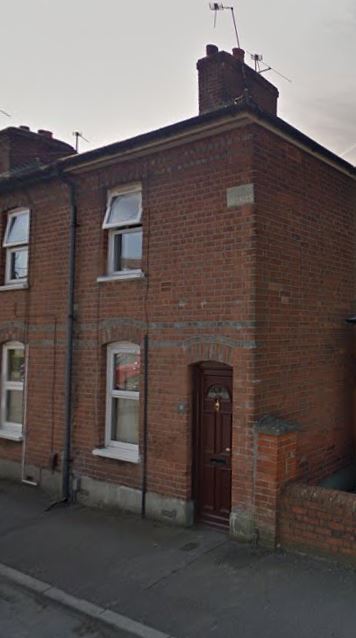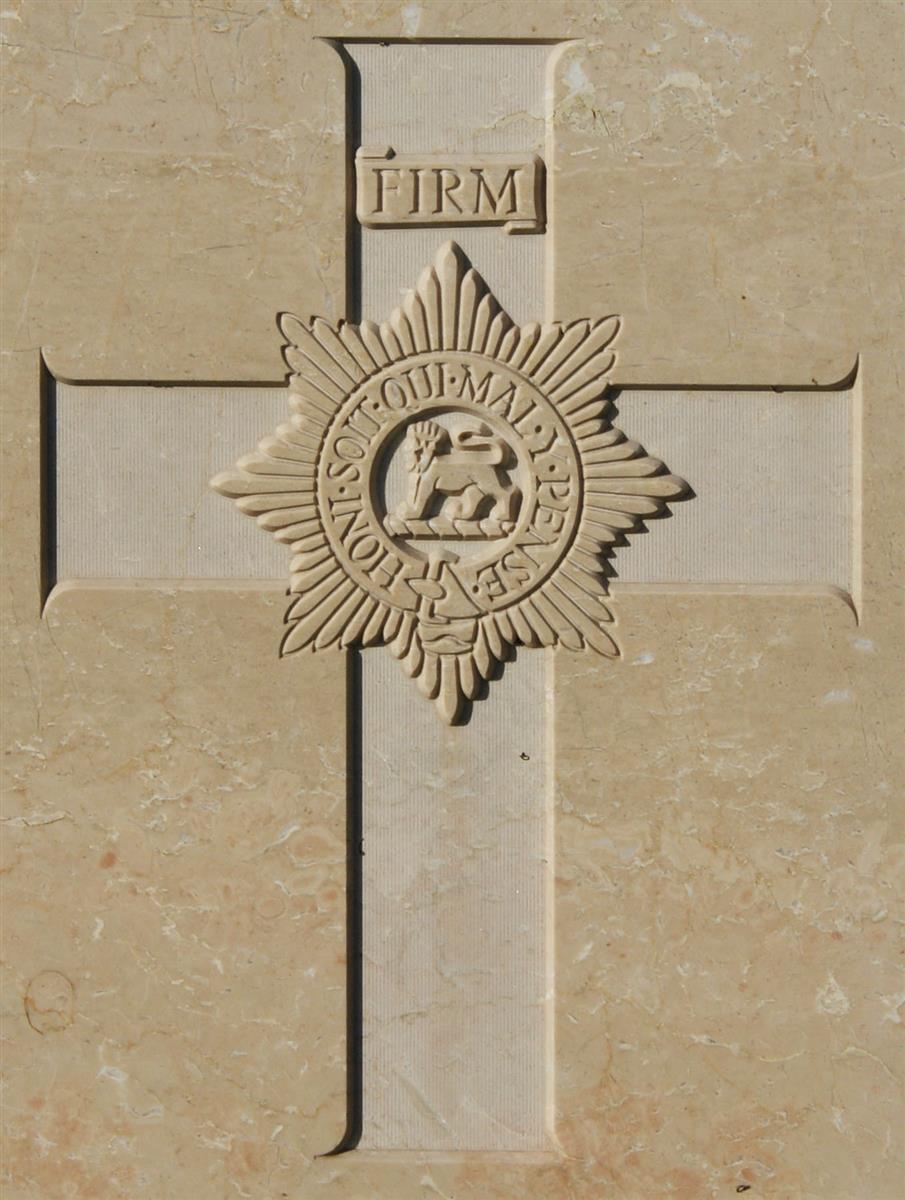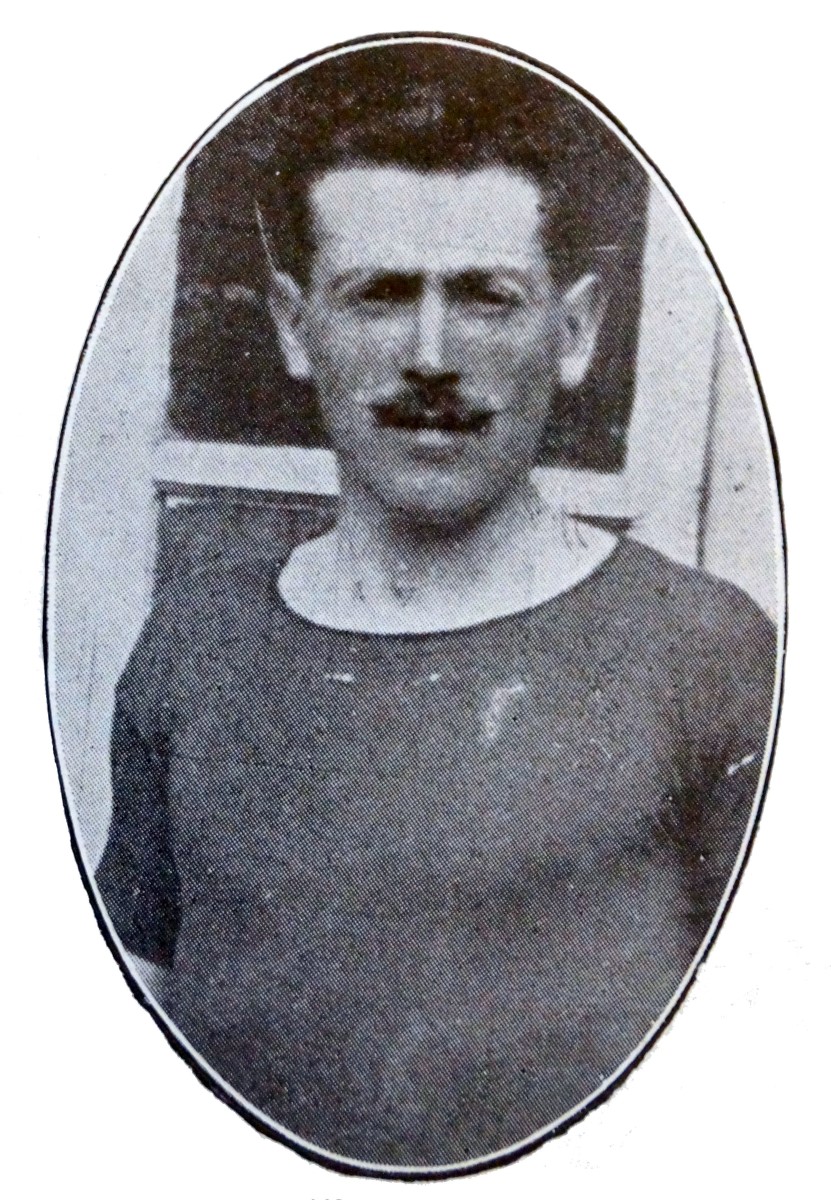Frederick Sawyer

11 York Road, the Sawyer's family home for many years. High on the wall is the old name for the terrace - Fairlight Cottages.
|
Frederick was born in Newbury in 1893 the son of Charles Sawyer and his wife Martha née Noyes. The couple had eleven children, eight of whom were still alive at the time of the 1911 census: Charles (born 1874), Sarah (1876), John (1877), Ellen (1880), Henry (1882), William (1887), George (1891), Frederick (1893). One of the three to die was Sarah’s twin, an earlier Ellen, who died in 1877 aged only one.
The family moved around: Farnborough (Hants), Twyford (Berks), Hungerford, Kintbury, and finally, Newbury. In 1903 they settled in York Road – at 1 Fairlight Cottages, which became 11 York Road when the street was numbered as a whole in 1910. They remained at this address for the remainder of Charles and Martha’s lives (they died there in 1926 and 1928 resp.).
Frederick worked as a plumber’s mate, in time he may well have become a plumber proper, but war intervened. He chose to volunteer for the local cavalry – the Berkshire Yeomanry where he was given the regimental number 2479. New recruits like Frederick were not sent out to Egypt in 1915 with the 1/1st Berkshire Yeomanry (which then served Gallipoli and Palestine). Instead he remained in England with the 2/1st, training for a form of warfare that was already all but obsolete. However, yeomanry training did include infantry tactics and weaponry. In September 1916 all second line Yeomanry units were instructed to send 160-200 men out to France as reinforcements. The men were given embarkation leave before being kitted out and sent to Infantry Base Depots in France from where they were allocated to infantry battalions in the field. The former Berkshire Yeomanry men were split between the 2nd Battalion, Royal Berkshire Regiment and the 3rd Battalion, Worcestershire Regiment. Frederick wound up with the 3rd Worcesters, as did another Newbury casualty, Arthur Whyllie.

The regimental badge of the Worcestershire Regiment, as used on CWGC headstones. |
An attack such as this would result in severe retaliation from the enemy artillery and very probably from counter attacking infantry. A very short distance away to the battalion’s left was the infamous Schwaben Redoubt, one of the most fought over pieces of land on the Western Front. None of this is alluded to in the terse entries in the battalion war diary. On 11 October the entry is typical:
War Diary, 3rd Battalion, Worcestershire Regiment – 11 October 1916
Bn in front trenches. 10th Cheshire Regiment relieved by 8th R N Lancs Regiment.
However, this was the day that Frederick lost his life, killed by enemy artillery andx unremarked upon by the battalion diarist. A summary of the month’s casualties lists the cold facts of the day: Other Ranks: killed 3, wounded 4.
The news reached his family who placed an announcement in the local paper:
Newbury Weekly News, 2 November 1916 – Killed in Action
SAWYER – Killed in action, October 11th, 1916, Frederick Sawyer, youngest son of Charles and Martha Sawyer, 11, York-road, Newbury, aged 22 years.
More details were printed in the news columns:
Newbury Weekly News, 2 November 1916 – Local War Notes
Mr and Mrs Charles Sawyer, 11, York-road, Newbury, have received notification of the death of their youngest son, Pte Frederick Sawyer, in action on October 11th inst somewhere in France. Pte Sawyer was 22 years of age, was in the Berks Yeomanry two years and transferred to the 3rd Worcester Regt. It was his first time in action, and he was killed by the bursting of a shell. A comrade had written to say that Pte Sawyer met his death bravely, was very cheerful, and a great favourite with his mates. A commanding officer and the Chaplain have also sent letters of sympathy. Mr Sawyer has three other sons serving their King and country: Corpl William Sawyer, Dorset Regiment, who resides at Renfrew, York-road, very early in the war was severely wounded necessitation the amputation of one of his legs, and is now a patient at Albion House, Newbury, receiving further medical treatment. He is a married man with a small family, Mr Sawyer’s other sons, John, in the Wiltshire Regt, and Harry Sawyer in the Flying Corps.
Frederick was buried in grave IV.T.2 at Pozieres British Cemetery, Ovillers-La Boisselle.
He was not forgotten by his family:
Newbury Weekly News, 11 October 1917 – In Memoriam
In ever loving memory of Pte Frederick Sawyer, 3rd Worcestershire Regt, dearly loved youngest son of Charles and Martha Sawyer, 11, York-road, who was killed in action in France October 11th, 1916.
Safe in the arms of Jesus,
Safe on his gentle breast;
Safe from all harm and sorrow,
Safely his soul shall rest.
From his sorrowing Father, Mother, Sisters and Brothers.

Frederick & Harry's names on the Newbury memorial. (upper left) |
After the war a number of war memorials were erected to commemorate Newbury’s fallen; Frederick is remembered on tablet 3 of the Newbury Town War Memorial where his name is below that of Harry Sawyer. The names on the memorial were placed by lot, resulting in a random distribution, except in the case of brothers, whose names were usually kept together, Harry, who died of wounds in 1918, was Frederick’s older brother.
Another brother, William, was mentioned in the newspaper article above – a more detailed report from 1915 serves well to tell his story:
Newbury Weekly News, 13 May 1915 – Local War Notes
Corporal William Sawyer, of the 1st Dorsets, wounded at La Basée on October 13th last, has just received his discharge from the London General Hospital at Camberwell.

William Sawyer |
Corporal Sawyer is a Newbury man, his parents living in York-road. As a lad he belonged to the St Mary’s Church Lads Brigade, and at football was considered a good player; whilst he was a member they won the Competition Shield of the District CLB. Later, he joined the Newbury Volunteers, now the Territorials, and ultimately enlisted in the 1st Dorset Infantry Regiment, in which he served seven years, and afterwards joined the Reserves. During his service, he was an enthusiastic football player, and in cross-country races he won fame for his regiment. He was one of the four of his company to win the regimental relay race for four years in succession, 1909 to 1912; he used occasionally to come to Newbury to play in matches for the Newbury Football Club, and he was a player when the club won the Hungerford League Cup, but a technical objection raised concerning Sawyer’s right to play in the match was upheld, and, as will be remembered the cup did not come to Newbury. In the Conservative Fete Sports of 1912, he won the 100 yards race and also the quarter-mile open race. He is married, and on the outbreak of the war, when the Reserves were called up, he was working at Southampton in the employ of Messrs Thorneycroft, and he rejoined his regiment.
Sawyer has had the misfortune to lose his leg, being severely wounded at La Basée, lying out under cover of one of the guns, left behind and passed over as dead by the enemy, who picked up the prisoners. Here he lay enduring excruciating pain, and on the fourth day, crawling towards our lines, a part of Devons found him and carried him in. He was sent over to England and placed in the Camberwell Hospital, where he received treatment for blood-poisoning set up by the shrapnel wound and aggravated by the long exposure. Sawyer must have a remarkably good constitution; the suffering he underwent during the treatment must have brought an end the life of an ordinary man; his temperature at one time stood at 105.4, and so little hope was entertained of being able to save him, that his wife was sent for, and the preliminary arrangement for his burial discussed, but to the surprise of the doctors and hospital staff, he rallied so far as to undergo amputation of the limb. It is not necessary to describe all that he has since passed through, but it may be said that subsequent operations were found necessary, and in all eight were made at dates separated by several days.
Sawyer speaks with pride of the skill of the doctors who attended him, but a considerable share of the credit is certainly due to his remarkable power of endurance. It can now be well imagined, however, what must now be the feelings of one who was once so successful and enthusiastic an athlete, delighting in all forms of physical activity, and full of animal spirits, to find himself a cripple for life. He has done his share of service for his country, and done it well, and it is earnestly hoped that he will not be forgotten or neglected in the future. He has a wife and child dependent upon him, and the allowance for wounded and discharged soldiers will be very welcome to him and them, but after all very inadequate, and it is hoped that something may be possible to enable him to earn a living, and partly compensate for the loss of a good situation before the war.

